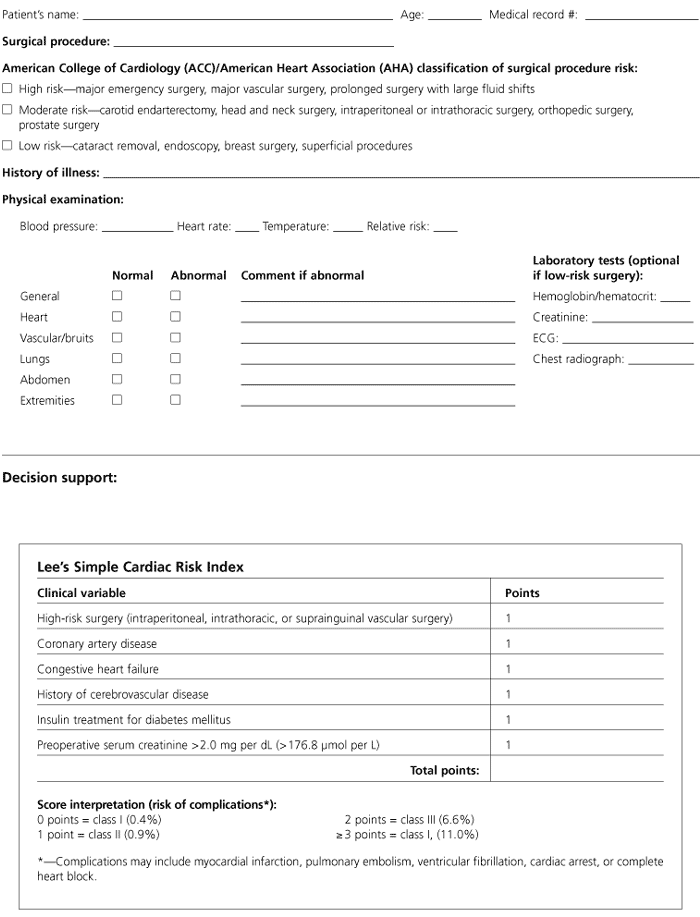
Am Fam Physician. 2004;69(8):1977-1980
Clinical Question
Can this patient safely undergo noncardiac surgery?
Evidence Summary
Guidelines from the American College of Physicians (ACP)1 and the American College of Cardiology/American Heart Association (ACC/AHA)2 address the preoperative evaluation of patients for noncardiac surgery. The ACP guideline was issued in 1997 and currently is being revised. The ACC/AHA guideline, which was written in 1996 and updated in 2002, forms the basis of the accompanying patient encounter form.
The decision to proceed with surgery begins with an assessment of risk. The physician should assess the patient's preoperative risk factors and the risks associated with the planned surgery. The patient encounter form in this Point-of-Care Guide uses the ACC/AHA classification of high, intermediate, and low surgical procedure risk, and provides examples for each category.
Careful attention must be given to specific risk factors that increase the patient's risk of surgical complications or death from the planned surgery. A number of studies3–5 have validated clinical decision rules for the assessment of cardiac risk. The study by Lee and colleagues5 is the most recent, simplest and, arguably, best-validated decision support tool. Lee's Simple Cardiac Risk Index and its interpretation are included in the patient encounter form as an aid in decision-making.
The ACC/AHA guideline2 advocates an approach that considers major, intermediate, and minor predictors of increased preoperative cardiovascular risk (see accompanying table). If a major risk predictor is present, nonemergency surgery should be delayed for medical management, risk-factor modification, and possible coronary angiography.
Functional status should be assessed in patients who have one or more intermediate risk predictors. Poor functional status is defined as less than 4 metabolic equivalents (METs). Patients with poor functional status may be able to do light work around the house, such as dusting or washing dishes, and can walk a block or two on level ground at a rate of 2 to 3 miles per hour (mph); however, they may be unable to climb a flight of stairs, walk up a hill, walk on level ground at a rate of 4 mph, or run a short distance. Examples of activities that require more than 4 METs include golf, bowling, dancing, doubles tennis, throwing a ball, and heavy work around the house.2
Patients with poor functional status should undergo noninvasive testing unless low-risk surgery is planned. Patients with good or excellent functional status require noninvasive testing only if they are having high-risk surgery. Finally, patients with minor risk predictors or no risk predictors should have noninvasive testing if they have poor functional status and are about to undergo high-risk surgery.
The selection of noninvasive testing depends on the clinical situation.2 Exercise stress testing is recommended in patients who are able to exercise and have a normal resting electrocardiogram (ECG); exercise echocardiography or perfusion imaging is recommended if the resting ECG is abnormal. Nuclear or echocardiographic pharmacologic stress imaging is recommended in patients who are unable to exercise and do not have second-degree atrioventricular block, bronchospasm, theophylline dependence, valvular dysfunction, or marked hypertension. In other clinical situations, the physician should consult a cardiologist for recommendations on how to proceed.
The patient encounter form includes an abbreviated version of the ACC/AHA algorithm for bedside use. However, physicians are strongly encouraged to refer to the complete ACC/AHA guideline2 and its more detailed algorithm for preoperative cardiac assessment. The encounter form links Lee's Simple Cardiac Risk Index5 to the ACC/AHA guideline's major, intermediate, and minor cardiac risk predictors.
Finally, the ACC/AHA guideline2 provides a reminder for physicians to consider perioperative beta blockade and measures to reduce the risk of venous thromboembolism. Good evidence supports the use of beta blockers in patients at high cardiac risk who are to undergo vascular procedures, patients who have recently required beta blockers to control symptoms of angina, patients with symptomatic arrhythmias or hypertension, and patients in whom preoperative assessment identifies untreated hypertension, known coronary disease, or major risk factors for coronary disease.2
Applying the Evidence
Mrs. Smith is a 72-year-old woman who is planning to undergo elective cholecystectomy. She has diabetes mellitus that is well controlled with oral medication, is an active walker, and has no known history of cardiovascular disease or renal insufficiency. What is her cardiac risk?
Answer
Elective cholecystectomy is moderate-risk surgery. The patient's Simple Cardiac Risk Index score is zero (0.4 percent risk of complications), she appears to have good functional status, and she has only one intermediate risk predictor (diabetes mellitus). The algorithm would suggest that she be cleared for surgery. The patient's physician should consider perioperative beta blockade and measures to prevent venous thromboembolism.
